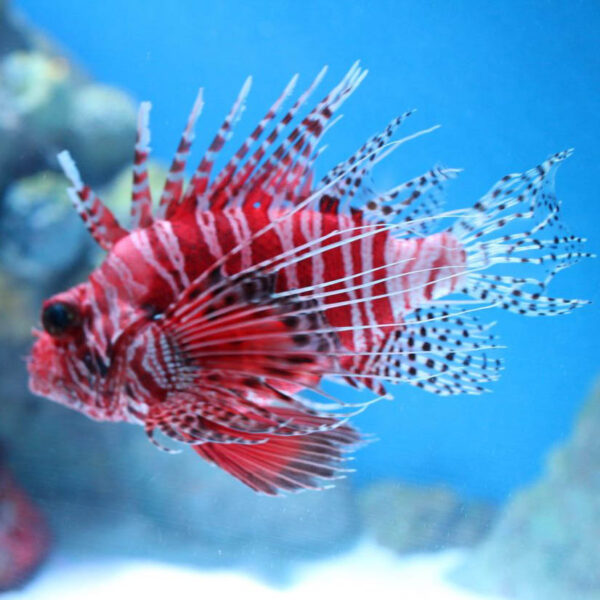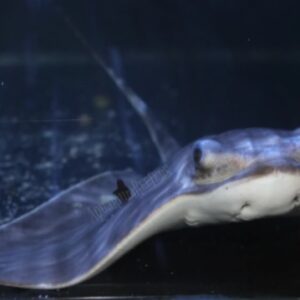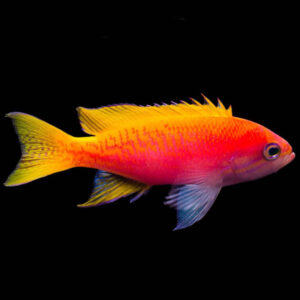Description
The Mombasa Lionfish, scientifically known as Pterois mombasae, can reach a maximum size of about 12 inches (30 cm). It has a striking and intricate appearance, characterized by its vibrant colour and elaborate fin rays. The body is adorned with a mixture of red, brown, and white stripes, providing effective camouflage in its natural habitat.
Taxonomy
The Mombasa Lionfish belongs to the genus Pterois, which is a part of the family Scorpaenidae. This family includes various other lionfish species known for their venomous spines and stunning appearance. The closest relatives of the Mombasa Lionfish within the genus Pterois include species like Pterois volitans and Pterois miles. The etymology of the species name “mombasae” refers to its native range around the coastal regions of Mombasa in Kenya.
Natural Habitat
The Mombasa Lionfish is found in the warm waters of the Indian Ocean, specifically along the eastern coast of Africa. Its natural habitat consists of coral reefs, rocky outcrops, and sandy bottoms, where it can seek shelter and hunt for prey. These lionfish are often encountered at depths ranging from 20 to 100 feet (6 to 30 meters), inhabiting both shallow and deeper reef environments.
Keeping Mombasa Lionfish Healthy:
Keeping the Mombasa Lionfish healthy requires careful attention to its specific care requirements. It is considered a moderately difficult species to care for. Providing a well-maintained aquarium with suitable conditions is crucial. The water temperature should be kept between 75°F and 82°F (24°C and 28°C), with a pH range of 8.1 to 8.4. The tank should have proper filtration and regular water quality maintenance.
Special Requirements and Feeding
The Mombasa Lionfish has special feeding requirements and should be offered a varied diet consisting of live or frozen meaty foods. This can include small fish, shrimp, squid, and other similar marine protein sources. Feeding should occur once every one to two days, ensuring the fish is adequately nourished. Care should be taken to avoid overfeeding.
How Many Should I Keep?
It is recommended to keep the Mombasa Lionfish individually or in a species-specific setup. Due to their territorial nature, multiple lionfish may exhibit aggressive behaviour towards each other, potentially leading to injuries or stress. Providing a spacious tank with ample hiding places will help reduce territorial disputes.
Hunting Method
The Mombasa Lionfish is a skilled predator that uses its venomous spines to capture prey. It typically employs an ambush hunting strategy, patiently waiting for suitable prey to come within striking distance. Once a target is within range, the lionfish rapidly extends its mouth and swallows the prey whole.
Lighting Preference
The Mombasa Lionfish prefers moderate to high lighting conditions in the aquarium.
Suitable Tank Mates
When considering tank mates for the Mombasa Lionfish, compatibility is crucial. It is best to choose larger, aggressive fish species that are not small enough to be considered prey. Avoid keeping it with slow-moving or docile fish that may become targets for the lionfish’s predatory instincts. Selecting tank mates with similar care requirements can help ensure a harmonious and stress-free environment.
Reproduction in the Wild
The Mombasa Lionfish, scientifically known as Pterois mombasae, reproduces through sexual reproduction in the wild. These lionfish exhibit external fertilization, where the female releases her eggs into the water column, and the male simultaneously releases his sperm to fertilize them. This process typically occurs during the breeding season, when environmental conditions are favourable for reproduction.
Breeding Pterois mombasae:
- Set up:
To breed Mombasa Lionfish in captivity, a dedicated breeding setup is required. A spacious tank with appropriate water parameters should be prepared, replicating the conditions found in their natural habitat. The tank should have suitable hiding places and live rock for the lionfish to lay their eggs on.
- Courtship/Spawning:
Courtship behaviour in Mombasa Lionfish involves intricate movements and displays by both males and females. The male initiates courtship by approaching the female, displaying his fins and colours to attract her. If the female is receptive, they engage in a series of spiralling movements and swimming together, culminating in the release of eggs and sperm.
- Rearing:
After successful spawning, the fertilized eggs will develop into larvae within a few days. The larvae are pelagic and drift in the water column. Rearing Mombasa Lionfish larvae is a challenging task, requiring specialized equipment and expertise. The larvae require proper nutrition, such as live rotifers and copepods, to ensure their healthy growth and development.
Sexual Dimorphism
Mombasa Lionfish exhibit sexual dimorphism, which means that males and females can be distinguished based on physical characteristics. However, the specific sexual dimorphic traits in this species are not well-documented.
Distribution
The Mombasa Lionfish, Pterois mombasae, is naturally found along the eastern coast of Africa, particularly in the region around Mombasa in Kenya. Its distribution encompasses the warm waters of the Indian Ocean, where it inhabits coral reefs, rocky outcrops, and sandy bottoms.
It is important to note that if Mombasa Lionfish are available in captivity, they are likely captive-bred individuals or line-bred strains derived from the original wild fish found in their native range.
Summary
In summary, the Mombasa Lionfish, or Pterois mombasae, is a fascinating species with specific requirements for successful breeding in captivity. Setting up a suitable breeding tank, observing courtship and spawning behaviours, and providing appropriate rearing conditions are essential for breeding success. This species exhibits sexual dimorphism, although the specific differences between males and females are not well-documented. Found along the eastern coast of Africa, the Mombasa Lionfish thrives in coral reef environments.
The Fish pictured here are representative only and the livestock you receive may vary in pattern, coloration, and shape.








